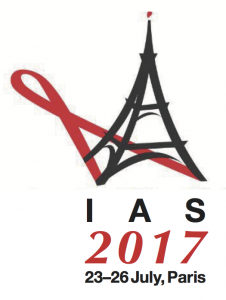Doravirine/3TC/TDF compared to efavirenz/FTC/TDF as first-line ART
10 August 2017. Related: Conference reports, Antiretrovirals, IAS 9th Paris 2017.
 Simon Collins, HIV i-Base
Simon Collins, HIV i-Base
Doravirine is a new once-daily NNRTI active against many first generation NNRTI resistant mutations, that is being developed by Merck in an FDC coformulated with generic lamivudine (3TC) and TDF.
Results from a randomised phase 3 study comparing the doravirine FDC to efavirenz/FTC/TDF (Atripla) in 728 treatment-naive participants were presented by Kathleen Squires from Thomas Jefferson University Hospital, Philadelphia.
This is an ongoing, double-blind, placebo controlled non-inferiority study defined using a 10% boundary for the 95% confidence interval.
Baseline characteristics included mean age 33 years, 85% male and 48% were white. Approximate mean (+/–SD) baseline CD4 and viral load were 420 (+/– 220) cells/mm3 and 4.4 (+/– 0.7) log copies/mL respectively with approximately 12% having CD4 count <200 cells/mm3 and 20% having viral load >5 logs.
At week-48, viral load <50 copies/mL was reported for 84.3% (307/364) vs 80.8% (294/364) of the doravirine vs efavirenz groups respectively, (difference 3.5%, 95%CI [–2.0 to +9.0]). Viral suppression was similar between arms in participants with <100,000 and >100,000 copies/mL (approximately 90% and 80% in each arm) and with baseline CD4 <200 and > 200 (approximately 69% vs 83% and 91% vs 90% in the doravirine vs efavirenz groups respectively). However, CD4 increases were similar between groups (+198 vs +188 cells/mm3; difference +10, 95%CI: –16 to +36).
There were slightly more protocol defined virological failures in the doravirine arm: n=22 (6%) vs n=14 (3%). Of these, 6 vs 4 were non-responders and 16 vs 10 involved viral rebound. Slightly fewer people in the doravirine arm discontinued for other reasons (n=35 vs 50).
Of approximately 24 genotype tests in each arm, n=5 in each group had NRTI resistance and n=6 vs 12 people had NNRTI resistance).
Doravirine was superior to efavirenz based on secondary endpoints CNS and lipid side effects.
For example, dizziness (9% vs 37%, p<0.001), sleep disorders/disturbances (12% vs 25%, p<0.001) and mood changes (4% vs 8%, p=0.03) were all significant. Similarly, fasting lipids included significantly reduced LDL (–1.6 vs +8.7 mg/dL, p<0.0001), cholesterol and triglycerides for the doravirine group but higher HDL increases (+1.9 vs +8.5 mg/dL) in the efavirenz group, and no data presented for HDL:TC ratio.
The timeline for regulatory submission for doravirine in this FDC is unclear but marketing will depend on FDC patents for the generic TDF in different countries.
These results support the doravirine FDC as a more tolerable alternative to efavirenz in treatment-naive participants.
Reference:
Squires KE et al. Fixed dose combination of doravirine/lamivudine/TDF is non-inferior to efavirenz/emtricitabine/TDF in treatment-naïve adults with HIV-1 infection: week 48 results of the Phase 3 DRIVE-AHEAD study. IAS 2017, Paris. Late breaker oral abstract TUAB0104LB.
http://programme.ias2017.org/Abstract/Abstract/5585

